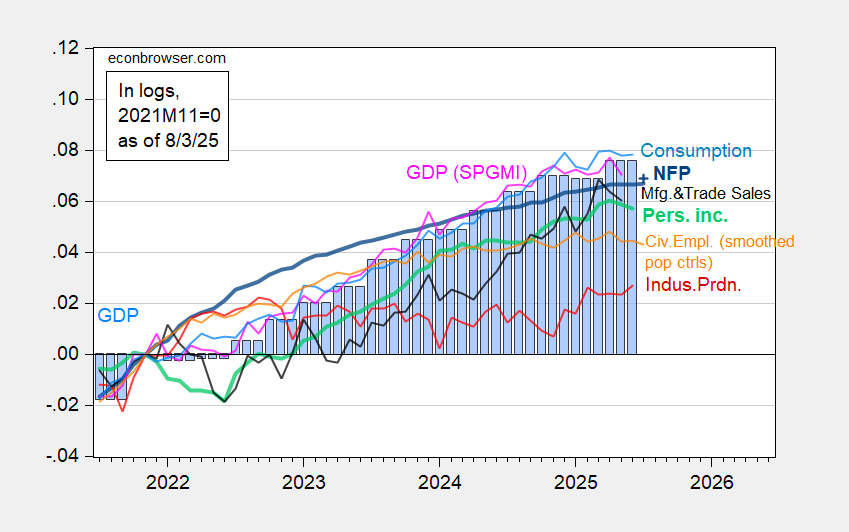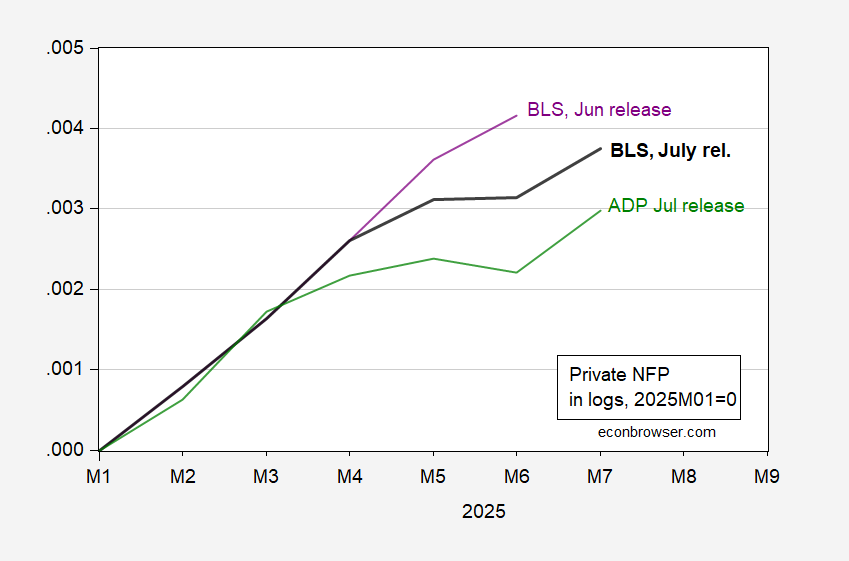This week’s livestream featuring Menzie Chinn and Lydia Cox, moderated by Mike Knetter, is Tuesday, Aug. 5, at 7 p.m. CDT (hosted by the Wisconsin Alumni Association):
Register here. Youtube video here. My slides here:
In the first half of the year, the Trump administration has reshaped many aspects of economic policy, often in ways that are at odds with the views of outside economists. As Trump’s economic agenda takes shape, many are wondering about its impact. How are tariffs affecting prices for consumers? Are the biggest impacts behind us or yet to come? How will the new federal budget affect the deficit? Will the administration exert more pressure on the Federal Reserve and its chair? And what does this all mean for the average American?
My pictorial assessment:
Figure 1: Nonfarm Payroll from CES (bold blue), implied NFP Bloomberg consensus as of 7/1 (blue +), civilian employment with smoothed population controls (orange), industrial production (red), personal income excluding current transfers in Ch.2017$ (bold light green), manufacturing and trade sales in Ch.2017$ (black), consumption in Ch.2017$ (light blue), and monthly GDP in Ch.2017$ (pink), GDP (blue bars), all log normalized to 2021M11=0. Source: BLS via FRED, Federal Reserve, BEA 2025Q2 advance release, S&P Global Market Insights (nee Macroeconomic Advisers, IHS Markit) (7/1/2025 release), and author’s calculations.
The labor market really does look like it’s slowing down…
Figure 2: Private nonfarm payroll employment, July release (bold black), Jun release (purple), ADP July release (green), all s.a., in logs, 2025M01=0. Source: BLS, ADP via FRED, and author’s calculations.


Policy works best when goals are complimentary. If one wants to construct a solid mutual defense alliance, it also makes sense to promote trade among allies. If one decides to diminish defensive alliances, then trade barriers may still be a bad idea, but at least they are consistent with the bad idea of reduced cooperation on defense.
Now, if containing China is a policy goal, as it seems to be for the U.S., and if India shares that goal, what trade policy might we want with India? Should we adopt a policy toward India which encourages India to open its high-tech sector to China?:
https://archive.is/20250730014004/https://indianexpress.com/article/business/tech-manufacturing-india-rethinks-china-blockade-10156549/#selection-729.0-729.60
Stupid, stupid, stupid.
Headline: “China welcomes 183 Brazil coffee sellers in wake of US tariffs.”
In his copy-and-pasted tariff letters Trump said: “We invite you to participate in the extraordinary Economy of the United States, the Number One Market in the World, by far.” Trump thinks that he has irreplaceable leverage against everyone, but they are diversifying their trade away from an unreliable US partner. UK, EU and Japan are busy at it, too. China is going to be a big winner.
By the way, I’m sure that diplomats around the world are scratching their heads over what purports to be a serious document but appears to be written by a nine-year-old with its weird phrasing and random capitalization.
Oh, and Brazil, too:
https://www.reuters.com/world/china/china-welcomes-183-brazil-coffee-sellers-wake-us-tariffs-2025-08-03/
Coffee, not tech. Our hemisphere, not China’s. But still a clear case of China taking advantage of pur stupidity.
so brazil finds another willing trading partner. the usa does not grow coffee beans in quantity on its own soil, and it never will. so trump has managed not only to increase the cost of imports due to tariffs. but he has encouraged china to create even more consumers of the coffee bean. supply and demand dictates that coffee creases will increase in the united states due to tariffs and supply constraint, unless somehow trump creates some demand destruction of coffee in the states. is this what is meant by trumpenomics? supercharged price increases. inflation.
If the felon-in-chief’s recent “shoot the messenger” declaration of bias at the BLS seems a bit paranoid, just remember, paranoia is a constant on the right. A classic, from Richard Hofstadter in 1964:
https://harpers.org/archive/1964/11/the-paranoid-style-in-american-politics/
The party which means to end U.S. democracy as we know sees conspiracies everywhere. Big surprise.
In Trump’s case, I think it is less paranoia than his ego always blaming others for his own failures. Conspiracies are just his invented cover stories to fool the rubes.